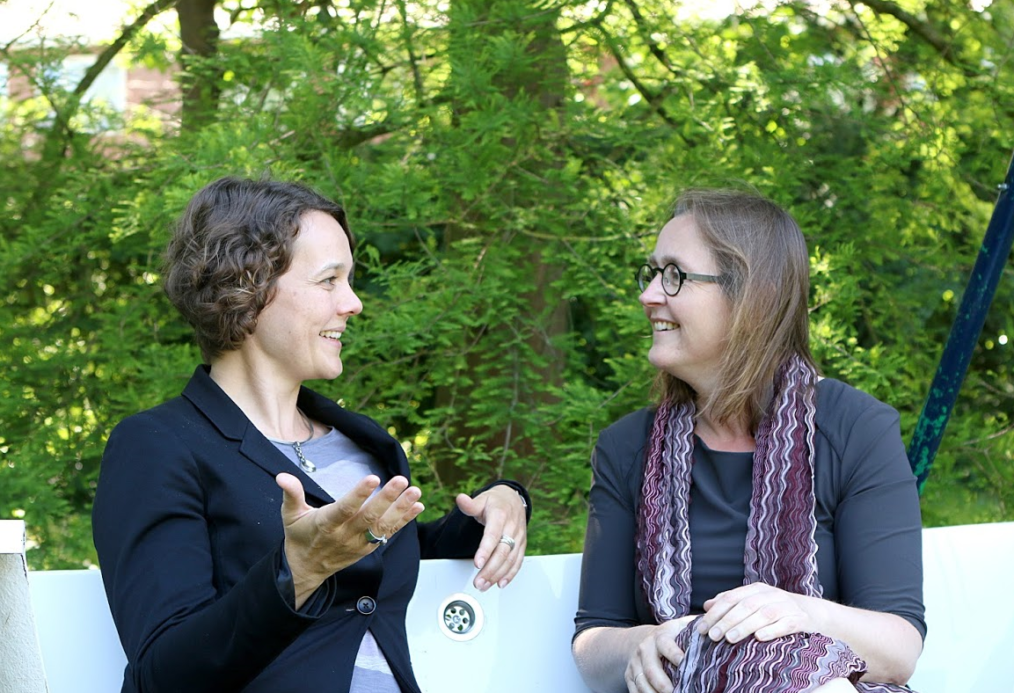
Duo-Interview: Perspectives on Emotion Regulation
We all have moments where our emotions take over. For some, this may be visible by shedding lots of tears. Others may stuff their face and yet others may smash some doors. These behavioural responses are not always appropriate. Therefore, in many everyday situations we try to regulate our emotions. Emotion regulation has been of interest to scholars in various fields of psychology. Mindwise has selected two University of Groningen experts from different sub-disciplines of psychology to answer our most burning questions regarding this topic. Clinical psychologist dr. Maaike Nauta studies emotion regulation in children and adolescents with behavioural problems. Dr. Susanne Scheibe is an organisational psychologist who examines emotion regulation at the work place.
You study emotion regulation in different contexts. What role does emotion regulation play among children and adolescents in a clinical context?
Dr. Nauta: Some children and adolescents develop an anxiety or depressive disorder. These children have intense and frequent negative emotions that interfere with their daily lives. They may experience great distress when feeling evaluated by peers, when undergoing a test, when speaking in front of their class, or when leaving home for less familiar places. As a response, they tend to ruminate or they may avoid those situations, rather than try to actively seek support or solve difficulties. Parents are important sources for learning emotion-regulation strategies. If parents are anxious themselves, if they are avoidant in expressing their own emotions, or have difficulty reacting to their child’s emotions, children are at risk for developing anxiety or depression.
In cognitive-behavioral therapy, children learn skills to recognize maladaptive thoughts and replace them with more adaptive thoughts. Moreover, they practice with approaching rather than avoiding situations that evoke negative emotions. In one of our studies on anxiety disorders, we found that through cognitive-behavioral therapy, children learn to think more positively and to actively solve problems in treatment.
What role does emotion regulation play in a work context?
“Sometimes emotions get in the way of effectively pursuing work tasks or maintaining positive relationships with coworkers and clients.”
Dr. Scheibe: During a typical workday we experience many events, big and small, positive and negative, that arouse our emotions. Think the friendly smile from your supervisor, or your computer crashing. Often, emotional reactions are useful. They tell us how well we do in our work and which people or activities to approach or avoid, or they give us the extra boost to persist when facing obstacles. However, sometimes emotions get in the way of effectively pursuing work tasks or maintaining positive relationships with coworkers and clients. In such cases, emotion regulation is important. We can regulate both the inner experience and the outward expression of emotions. For example, we may reappraise difficulties as part of the process, or keep ourselves back from snapping angrily at a supervisor. Effective emotion regulation predicts many positive work outcomes, from job performance to well-being.
You study emotion regulation in different age groups. Dr. Scheibe, you are interested in the aging population; Dr. Nauta, your studies involve children and adolescents. A question we could ask both of you: “Do we get better at regulating our emotions once we get older?”
“As life gets more complex, the strategies of dealing with life’s events also get more differentiated.”
Dr. Nauta: On the one hand, children and adolescents impressively increase their repertoire of emotion-regulation strategies as they grow older. As life gets more complex, the strategies of dealing with life’s events also get more differentiated. Young children first need to develop the capacity to recognize their own emotions. As they grow older, they learn to recognize how others are feeling, and they develop a variety of ways of dealing with negative emotions. Also, they learn that some emotional reactions are adaptive in some contexts but not in others. On the other hand, there is an increase in the onset of anxiety and depressive disorders, starting in childhood, increasing in adolescence, meaning that some youth have difficulty in finding an adaptive way of handling their emotions.
Dr. Scheibe: Research on emotional development from early to late adulthood also shows improvements in several aspects of emotion regulation. Probably, the most important reason is experience. Over the years, as we encounter emotional events, we learn what works for us to maintain our well-being. For example, compared to young adults, older adults focus more on the positive, tend to avoid unnecessary conflicts, and adopt a more accepting attitude toward life’s challenges. Naturally not everyone experiences improvements in emotion regulation with age. Older adults are a diverse bunch. Nevertheless, the general age trend is positive. Currently my research collaborators and I seek to better understand whether this helps older workers more effectively navigate the emotional challenges of their work day.
“Young adults are more likely to experience anger and anxiousness than older adults, which have been linked to workaholism and counterproductive work behaviors”
Dr. Nauta asks Dr Scheibe: In the context of your work, when it comes to emotion regulation, is it important to differentiate between the different emotions (such as anxiety, anger, sadness, happiness)?
Dr. Scheibe: Yes, the type of emotional experience certainly makes a difference. In my work, I have mainly distinguished emotional states in terms of valence (negative or positive states) and arousal (low or highly activated states). These two dimensions of emotional experience are very helpful to understand age trajectories and work-related outcomes of emotional experiences. For example, older adults tend to experience more low-arousal positive emotions (such as being calm and content) than young adults, which has been linked with job satisfaction and feelings of a good fit with the job. Conversely, young adults are more likely to experience high-arousal negative emotions (such as anger and anxiety) than older adults, which has been been linked to workaholism and counterproductive work behaviors. Age differences are largely absent for high-arousal positive emotions (such as excitement and enthusiasm) and low-arousal negative emotions (such as boredom and fatigue). Different emotional reactions can thus help us understand why young and older worker may respond differently to work conditions and work experiences.
Dr. Scheibe asks Dr. Nauta: I find it very interesting to think about the role of parents – as a contextual factor – in children’s emotional development. How do you take into account this role of parents in the development of anxiety or depressive disorders in children, and in treating such disorders?
“With respect to treating anxious children and adolescents, youth-focused interventions are very effective.”
Dr. Nauta: We know that anxiety and depression “run in families”. The most consistent finding with regard to parent behavior is that, overall, parents of anxious children tend to be more controlling towards their children and grant less autonomy than other parents do. Note that it goes both ways: anxious child behavior elicits protective parenting, and protective parenting can lead to anxiety in children. We do not see a consistent difference between families of anxious children and other families in terms of experienced parental rejection or warmth.
With respect to treating anxious children and adolescents, youth-focused interventions are very effective. Efforts to provide all sorts of additional parent and family interventions have – on average – not resulted in better outcomes. This does not imply that parents do not change during parent interventions, but rather it implies that parents adapt their worries and protective behaviors over the course of child-focused treatment, even when these parental worries or behaviors are not explicitly addressed in a parent intervention. The one parent intervention that does seem to have additional benefits over and above youth-focused interventions is a specific training to reinforce approach behavior in a step-by-step way. During this intervention, parents are instructed to support their children in seeking out challenging situations. Parents then learn that their children can cope with negative emotions and challenging situations, even when they do not take over. I guess what it comes down to is that parents are supportive, accept negative emotions in their children, and encourage them to explore and learn from experience (rather than avoid and focus on possible negative outcomes).
What are your wishes for emotion regulation research in the future? Which questions will or should be answered?
Dr. Nauta: There are many interesting avenues to take from here. First, most treatment outcome studies have been limited to pre-, post-, and follow-up assessments. I would like to learn more about the individual change trajectories and find out how changes in child and parent emotions, thoughts, and behaviors are interrelated over time. Who and what changes first? Are there individual differences and can we identify families with different change trajectories? And during treatment, is it necessary to teach children to reappraise their thoughts through cognitive restructuring, or does learning by doing and experiencing in changing cognitions? Finally, children with anxiety disorders may also be very sad or angry at times, to the point that they can also be diagnosed with depression or disruptive behavioral disorders. Why do some children suffer specifically from anxiety, while others also have difficulty with regulating other emotions? And what role do parents play there? To answer these research questions, I am lucky to collaborate with several PhD and post-Master students as well as other researchers.
Dr. Scheibe: There are many exciting questions still to be answered regarding aging and emotion regulation in work settings. For example, do older workers have an advantage over young workers when they are emotionally challenged in their work, and are there situations in which age-related advantages can no longer be expected? Do older workers use different strategies to regulate emotions compared to young workers or are they better at tailoring strategies to situational demands? Do older-age advantages in emotion regulation also appear when it comes to regulating other people’s emotions, such as those of colleagues, supervisors, subordinates, and clients? Do some occupations stimulate people to develop their emotion regulation skills as they get older more than other occupations? Answering these questions will help us understand how emotional development impacts work experiences, and how work experiences in turn shape emotional development in adulthood.
NOTE: picture by Sander van Lien



